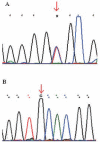Claudin 1 and Claudin 7 Gene Polymorphisms and Protein Derangement are Unrelated to the Growth Pattern and Tumor Volume of Colon Carcinoma
- PMID: 23675182
- PMCID: PMC3614738
Claudin 1 and Claudin 7 Gene Polymorphisms and Protein Derangement are Unrelated to the Growth Pattern and Tumor Volume of Colon Carcinoma
Abstract
Tight junctions together with adherens junctions are important for preserving tissue integrity. In tumors the normal tissue structure is lost which results in a disorganization and change of phenotype. In this study we assessed the complexity of the invasive front of colon carcinoma using an objective morphometrical technique based on the estimation of fractal dimension and number of free tumor cell clusters. The complexity of the invasive front was correlated to Claudin 1 and Claudin 7 protein expression as well as genetic polymorphisms of their genes. Thirty-three colon carcinomas were used. Images from the invasive front of the tumors were captured and used to calculate a complexity index of the invasive front. The tight junction proteins Claudin 1 and Claudin 7 were stained immunohistochemically in the tumor and in the surrounding normal mucosa. Screening of their genes was performed using DNA sequencing. A significant aberration of protein expression was seen for both Claudin 1 and Claudin 7 compared to normal mucosa. Both homozygous and heterozygous polymorphisms in exon 2 of claudin 1 were found. In claudin 7 a homozygous polymorphism was seen in exon 4. All individuals with tumors that showed either of these polymorphisms also showed the same polymorphism in the adjacent normal mucosa. A significant correlation was found between polymorphisms in CLDN 7 and tumor differentiation p<0.02. However no correlations were found to Complexity Index, tumor size, localization or tumor stage (pT and pN). The results show that there is a perturbed expression of claudin 1 and claudin 7 proteins in colon tumors compared to normal mucosa. A high incidence of polymorphisms was found in normal tissue and tumors. It remains to be shown if these polymorphisms are coupled to the occurrence of colon carcinomas.
Keywords: celladhesion; claudin; colon carcinoma; complexity index; polymorphism tight junction; tumor growth.
Figures


Similar articles
-
Disturbed expression of E-cadherin, beta-catenin and tight junction proteins in colon carcinoma is unrelated to growth pattern and genetic polymorphisms.APMIS. 2008 Apr;116(4):253-62. doi: 10.1111/j.1600-0463.2008.00894.x. APMIS. 2008. PMID: 18397460
-
Tumor volume of colon carcinoma is related to the invasive pattern but not to the expression of cell adhesion proteins.APMIS. 2009 Mar;117(3):205-11. doi: 10.1111/j.1600-0463.2008.00011.x. APMIS. 2009. PMID: 19245593
-
Polymorphisms in the CLDN1 and CLDN7 genes are related to differentiation and tumor stage in colon carcinoma.APMIS. 2014 Jul;122(7):636-42. doi: 10.1111/apm.12211. Epub 2014 Jan 31. APMIS. 2014. PMID: 24479816
-
Claudin-1, A Double-Edged Sword in Cancer.Int J Mol Sci. 2020 Jan 15;21(2):569. doi: 10.3390/ijms21020569. Int J Mol Sci. 2020. PMID: 31952355 Free PMC article. Review.
-
MicroRNA Regulation of Endothelial Junction Proteins and Clinical Consequence.Mediators Inflamm. 2016;2016:5078627. doi: 10.1155/2016/5078627. Epub 2016 Nov 24. Mediators Inflamm. 2016. PMID: 27999452 Free PMC article. Review.
Cited by
-
Investigating the association between polymorphisms in connective tissue growth factor and susceptibility to colon carcinoma.Mol Med Rep. 2015 Apr;11(4):2493-503. doi: 10.3892/mmr.2014.3083. Epub 2014 Dec 11. Mol Med Rep. 2015. PMID: 25502877 Free PMC article.
-
Polymorphisms in CLDN1 are associated with age and differentiation of triple-negative breast cancer patients.Biosci Rep. 2019 Apr 23;39(4):BSR20181952. doi: 10.1042/BSR20181952. Print 2019 Apr 30. Biosci Rep. 2019. PMID: 30910845 Free PMC article.
References
-
- Franzen LE, Hahn-Stromberg V, Edvardsson H, Bodin L. Characterization of colon carcinoma growth pattern by computerized morphometry: Definition of a complexity index. Int. J. Mol. Med. 2008;22(4):465–472. - PubMed
-
- Cross SS. Fractals in pathology. J. Pathol. 1997;187(1):1–8. - PubMed
-
- Cross SS, Bury JP, Silcocks PB, Stephenson TJ, et al. Fractal geometric analysis of colorectal polyps. J. Pathol. 1994;172(4):317–323. - PubMed
-
- Landini G, Rippin JW. Fractal dimensions of the epithelial-connective tissue interfaces in premalignant and malignant epithelial lesions of the floor of the mouth. Anal. Quant. Cytol. Histol. 1993;15(2):144–149. - PubMed
-
- Tlsty TD. Cell-adhesion-dependent influences on genomic instability and carcinogenesis. Curr. Opin. Cell Biol. 1998;10(5):647–653. - PubMed
LinkOut - more resources
Full Text Sources
Miscellaneous
